In the 1967 movie The Graduate, Benjamin’s Alfa Romeo Spider breaks down in a citrus grove on the way to the church where Elaine is getting married.
That grove bordered Fruit Street, so-called because La Verne, CA (the film location) was a prime area for citrus production. Those who knew the area chuckled at the final scene, where Benjamin and Elaine boarded a serendipitous D Street bus. There were no public buses on D Street, and still aren’t to this day.
The citrus groves are long gone, but La Verne remains an excellent place to grow citrus — as does most of Southern California, wherever it isn’t paved over.

An AI rendering of the La Verne, CA Metrolink station. It was once the city of lemons!
A (Very) Brief History of the Lemon Tree
Lemons are native to Southeast Asia. They were introduced to the Mediterranean region around the first century AD. From there, they made their way to the Americas with Spanish explorers.
The padres — bless their hearts — bought the lemon to Spain’s California territory around 1769.
Today, California is one of the leading lemon growers in the USA, producing millions of pounds of this beloved citrus annually. Lemon cake, anyone?
Popular Lemon Varieties
The following lemon varieties thrive in Southern California’s Mediterranean climate:
- Eureka Lemon: The classic “store-bought” lemon with tart juice and negligible seeds. It bears fruit year-round.
- Meyer Lemon: A sweeter, smaller hybrid that’s a cross between a lemon and a mandarin orange. Meyer lemons are perfect for desserts and cocktails.
- Lisbon Lemon: Similar to the Eureka but with thinner skin, Lisbon lemons produce fruit year-round and are exceptionally hardy.
- Ponderosa Lemon: Sometimes referred to as the “giant” lemon. Ponderosa offers a milder, less acidic flavor.
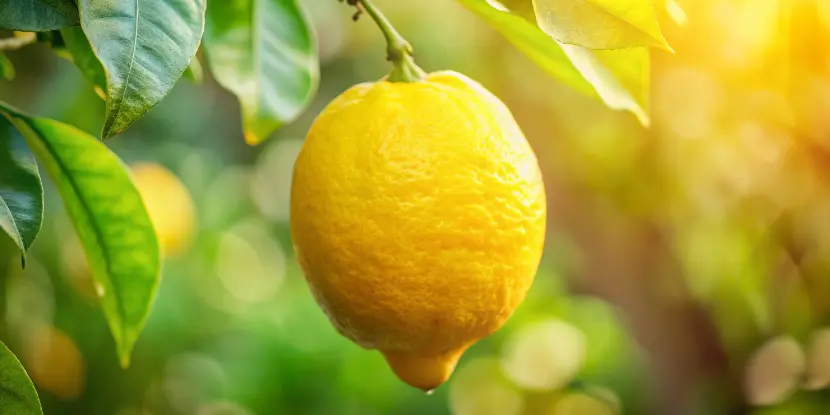
A ripe Eureka lemon begs to be picked.
Optimal Growing Conditions
Pay attention to light, temperature, and soil to ensure your tree flourishes.
Light
- Lemon trees require full sun — at least six to eight hours of direct sunlight daily.
- Place your tree in the brightest, sunniest spot in your yard or on your balcony.
Temperature
- Lemon trees prefer temperatures between 70°F and 85°F.
- Unexpected frost in the winter can damage your tree.
- Cover outdoor trees with frost cloth if temperatures are predicted to drop below 40°F.
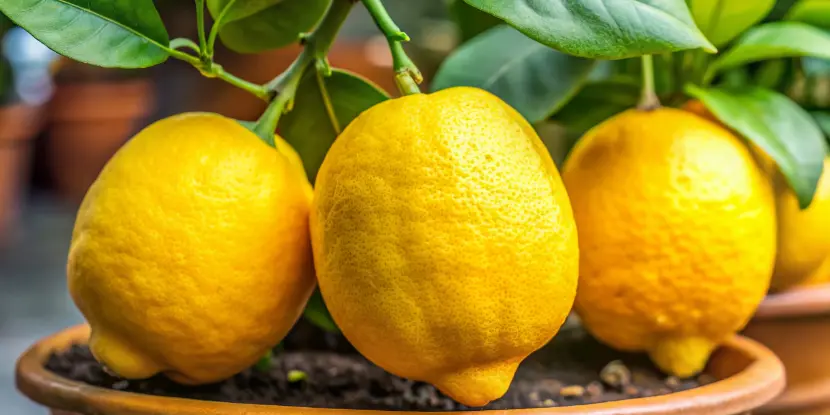
Meyer lemons are a sweeter, smaller hybrid that’s a cross between a lemon and a mandarin orange.
Soil
- Lemon trees love well-draining, slightly acidic soil with a pH level between 5.5 to 6.5.
- Ensure the planting area has good drainage. Saturated soil can lead to root rot.
Propagating a Lemon Tree
- Lemon trees are best propagated through cuttings rather than seeds.
- Cut a 6-inch section from the tip of a healthy, mature branch in the spring or summer.
- Remove any leaves from the lower half of the cutting and dip it in rooting hormone before planting it in well-draining potting soil.
- Keep the cutting moist and warm. Roots should start to form within a few weeks.
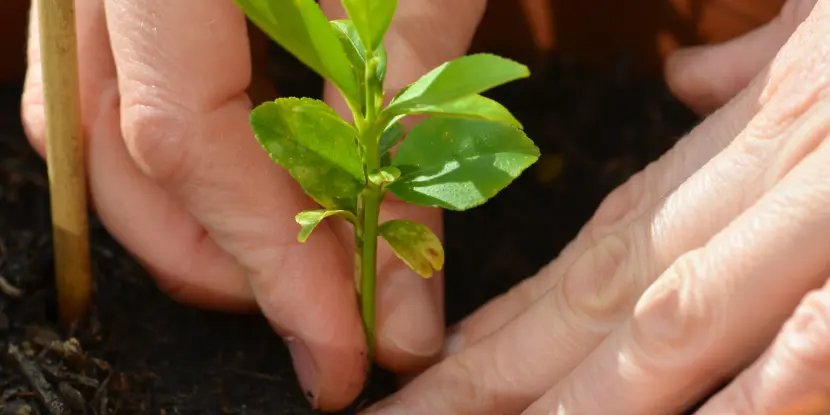
A gardener plants a lemon seedling.
How to Plant a Lemon Tree
Preparing the Site
- Choose a spot with full sun and well-draining soil.
- Clear the area of weeds or debris.
- Dig a hole twice as wide and slightly deeper than the root ball of your tree.
Planting the Tree
- Remove the tree from its container and gently loosen the roots.
- Place the tree in the hole’s center, ensuring it is straight.
- Backfill with soil, tamping down gently to remove air pockets.
- Water thoroughly after planting.
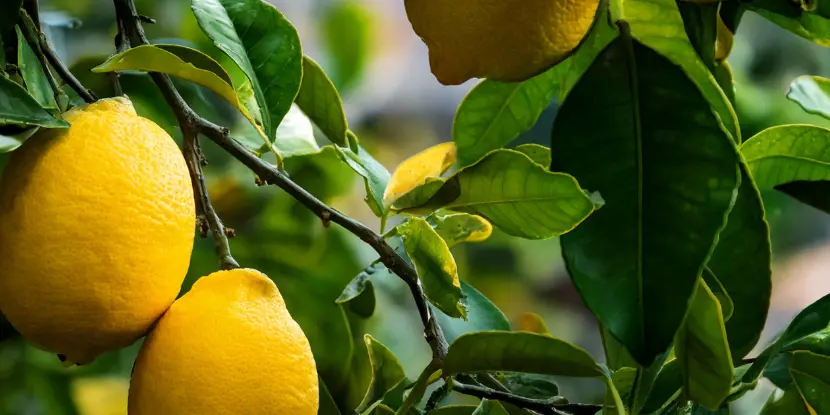
Lisbon lemons: from Portugal to your California garden and, ultimately, your glass.
Lemon Tree Care
Water
Lemon trees need consistent moisture but hate soggy soil.:
- Newly Planted Trees: 2–3 times per week until the roots are established.
- Mature Trees: Deeply once a week or whenever the top few inches of soil are dry.
Fertilizer
Lemon trees are heavy feeders. Regular fertilization is crucial.
- Use a citrus-specific fertilizer rich in nitrogen.
- Fertilize every 6–8 weeks during the growing season (spring through early fall).
- Avoid over-fertilizing in winter, when the tree’s growth slows.
Pests & Diseases
- Aphids and whiteflies can infest your tree. Use insecticidal soap or neem oil to tackle these nuisances.
- Citrus leaf miner causes curly, discolored leaves. Prune affected areas and apply organic treatments.
- Prevent fungal diseases like root rot by avoiding overwatering and ensuring good drainage.
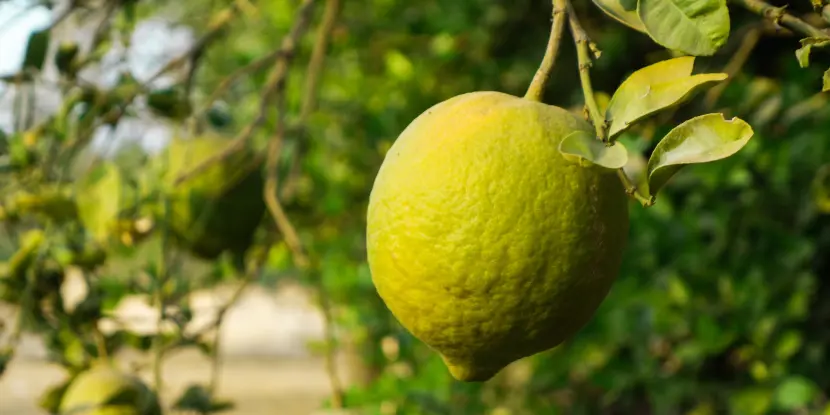
An unripe Ponderosa lemon. Unlike other fruits, lemons don’t continue to ripen once picked.
Pruning
- Prune in late winter or early spring to promote new growth.
- Remove dead, damaged, or crossing branches.
- Thin out overcrowded areas to improve air circulation and light penetration.
Harvesting
A mature lemon tree can produce up to 150 lemons per year. That’s a lot of lemonade!
Unlike other fruits, lemons don’t ripen after being picked, so ensure they’re ready before harvesting,
- Citrus trees generally take 6–9 months from bloom to fruit maturity.
- Most lemons are ready to pick when they turn entirely yellow and slightly glossy.
- Color doesn’t always indicate ripeness; taste a few fruits before harvesting the whole crop.
- Gently twist the fruit off the tree or use pruning shears to avoid damaging the branches.
- Store at room temperature for optimal flavor.
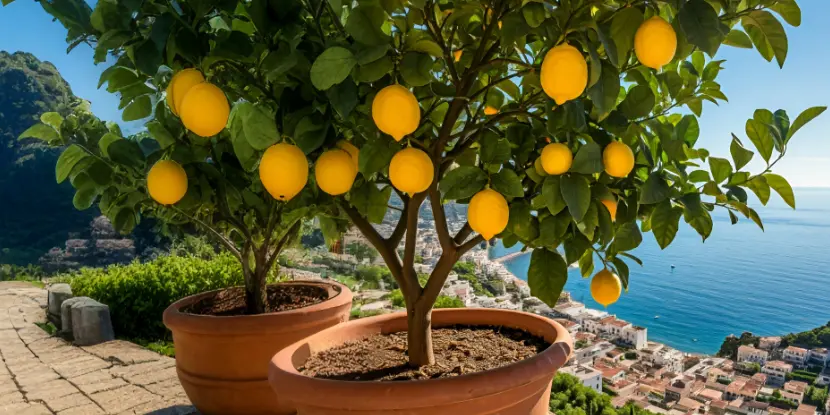
Potted lemon trees overlooking the Mediterranean Sea.
Growing Lemon Trees in Pots
Short on yard space? No problem — lemon trees do well in pots with proper care:
- Choose a large pot with a drainage hole.
- Use high-quality, well-draining potting mix.
- Water frequently, as potted trees dry out faster than those in the ground.
- Place the pot in a sunny spot and protect it from frost.
- Fertilize every 2–3 months with a citrus-specific fertilizer.
- Prune regularly to maintain shape and encourage new growth.
- If you live in a colder climate, consider growing your citrus tree in a container to be brought indoors during winter.
Creative Ways to Use Your Fresh Lemons
Fresh, homegrown lemons aren’t just for lemonade! Here are some ideas to put yours to use:
- Add a burst of flavor to your meals with fresh lemon juice.
- Make creamy lemon curd for pastries.
- Create refreshing lemon-infused water or cocktails.
- Use lemon zest to elevate baked goods and marinades.
- Preserve lemons by pickling them for use in Mediterranean recipes.

The moment we’ve all been waiting for — fresh lemonade arrives!
FAQs: Lemon Tree Care
Q: How long does it take for a lemon tree to produce fruit?
A lemon tree typically takes 3–5 years to produce fruit.
Q: Can I grow a lemon tree indoors?
Yes! Choose a dwarf variety, place it near a sunny window, and use grow lights during the winter.
Q: Why are my lemon tree leaves turning yellow?
Yellow leaves can indicate overwatering, nutrient deficiencies, or poor drainage. Or maybe the leaves identify as fruit (just a joke, folks). Assess your watering habits and consider fertilizing.
Q: How often should I water my lemon tree?
Water your lemon tree deeply once every 1–2 weeks, allowing the soil to dry slightly between waterings. Adjust based on climate and season.
Q: What type of soil is best for lemon trees?
Lemon trees thrive in well-draining, slightly acidic soil with a pH between 5.5 and 6.5. A quality citrus potting mix can provide the ideal conditions.
Q: When should I fertilize my lemon tree?
Fertilize your lemon tree with a citrus-specific fertilizer every 4–6 weeks during the growing season (spring and summer). Reduce feeding during fall and winter.
Q: Can lemon trees survive in cold climates?
Lemon trees are sensitive to frost and prefer temperatures above 50°F (10°C). If you live in a colder region, consider growing your tree in a container to be brought indoors during winter.
Q: How do I prune a lemon tree?
Prune your lemon tree annually to remove dead or diseased branches, encourage airflow, and shape the tree. The best time to prune is late winter or early spring.
Q: What pests commonly affect lemon trees?
Common pests include aphids, spider mites, and scale insects. Check the leaves and stems regularly for signs of infestation and treat them with insecticidal soap or horticultural oil if necessary.

